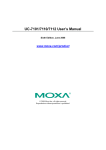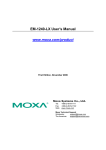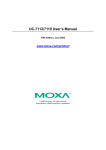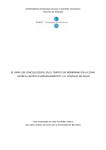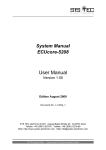Download Moxa Technologies UC-7110 User`s manual
Transcript
UC-7110 Series User’s Manual www.moxa.com/product First Edition, September 2004 Moxa Technologies Co., Ltd. Tel: +886-2-8919-1230 Fax: +886-2-8919-1231 www.moxa.com [email protected] (Worldwide) [email protected] (The Americas) UC-7110 Series User’s Manual The software described in this manual is furnished under a license agreement and may be used only in accordance with the terms of that agreement. Copyright Notice Copyright 2004 Moxa Technologies Co., Ltd. All rights reserved. Reproduction without permission is prohibited. Trademarks MOXA is a registered trademark of The Moxa Group. All other trademarks or registered marks in this manual belong to their respective manufacturers. Disclaimer Information in this document is subject to change without notice and does not represent a commitment on the part of Moxa. Moxa provides this document “as is,” without warranty of any kind, either expressed or implied, including, but not limited to, its particular purpose. Moxa reserves the right to make improvements and/or changes to this manual, or to the products and/or the programs described in this manual, at any time. Information provided in this manual is intended to be accurate and reliable. However, Moxa assumes no responsibility for its use, or for any infringements on the rights of third parties that may result from its use. This product might include unintentional technical or typographical errors. Changes are periodically made to the information herein to correct such errors, and these changes are incorporated into new editions of the publication. Table of Contents Chapter 1 Introduction ..................................................................................................1-1 Overview.................................................................................................................................. 1-2 Package Checklist .................................................................................................................... 1-2 Product Features ...................................................................................................................... 1-2 Product Specifications ............................................................................................................. 1-3 Hardware Specifications (UC-7110-LX)...................................................................... 1-3 Software Specifications (UC-7110-LX) ....................................................................... 1-4 Hardware Block Diagram ........................................................................................................ 1-5 Appearance .............................................................................................................................. 1-5 Dimensions .............................................................................................................................. 1-6 Installing UC-7110................................................................................................................... 1-7 LED Indicators......................................................................................................................... 1-8 Wiring Requirements ............................................................................................................... 1-8 Connecting the Power................................................................................................... 1-9 Grounding UC-7110 ..................................................................................................... 1-9 Connecting Data Transmission Cables .................................................................................... 1-9 Connecting to the Network........................................................................................... 1-9 Connecting to a Serial Device .................................................................................... 1-10 Serial Console Port ..................................................................................................... 1-10 Additional Functions...............................................................................................................1-11 Reset Button ............................................................................................................... 1-11 Real Time Clock......................................................................................................... 1-12 Chapter 2 Getting Started .............................................................................................2-1 Powering on UC-7110 ............................................................................................................. 2-2 Connecting UC-7110 to a PC................................................................................................... 2-2 Console Port ................................................................................................................. 2-2 Telnet............................................................................................................................ 2-3 Configuring the Ethernet Interface .......................................................................................... 2-4 Developing Your Applications ................................................................................................. 2-6 Installing the UC-7110 Tool Chain .............................................................................. 2-6 Compiling Hello.c ........................................................................................................ 2-7 Uploading “Hello” to UC-7110 .................................................................................... 2-8 Running “Hello” on UC-7110 ...................................................................................... 2-9 Make File Example Code ........................................................................................... 2-10 Chapter 3 Software Package ........................................................................................3-1 UC-7110 Software Architecture............................................................................................... 3-2 Read-Only File System (ROMFS)................................................................................ 3-3 Journaling Flash File System (JFFS2) .......................................................................... 3-3 UC-7110 Software Package ..................................................................................................... 3-4 Chapter 4 Configuring UC-7110 ...................................................................................4-1 Enabling and Disabling Daemons............................................................................................ 4-2 Adding a Web Page.................................................................................................................. 4-3 Configuring Dial-in/Dial-out Service ...................................................................................... 4-4 Dial-out Service............................................................................................................ 4-4 Dial-in Service.............................................................................................................. 4-4 How to Mount a Remote NFS Server ...................................................................................... 4-5 Upgrading the Kernel & Root File System .............................................................................. 4-5 Upgrading the User Directory.................................................................................................. 4-7 User Directory Backup—UC-7110 to PC................................................................................ 4-8 Loading Factory Defaults ........................................................................................................ 4-9 Mirroring the Application Program and Configuration............................................................ 4-9 How to Autostart User Applications on Bootup....................................................................... 4-9 Checking the Kernel and User Directory Versions .................................................................. 4-9 Chapter 5 UC-7110 Device API .....................................................................................5-1 RTC (Real Time Clock) ........................................................................................................... 5-2 Buzzer ...................................................................................................................................... 5-2 UART Interface........................................................................................................................ 5-2 Chapter 6 UC Finder ......................................................................................................6-1 Windows UC Finder ................................................................................................................ 6-2 Linux ucfinder.......................................................................................................................... 6-5 Appendix A System Commands..................................................................................... A-1 busybox (V0.60.4): µClinux normal command utility collection ........................................... A-1 File manager ................................................................................................................ A-1 Editor ........................................................................................................................... A-1 Network ....................................................................................................................... A-2 Process......................................................................................................................... A-2 Other ............................................................................................................................ A-2 MOXA Special Utilities .............................................................................................. A-2 Appendix B SNMP Agent with MIB II & RS-232 Like Group ......................................... B-1 Appendix C FAQ for UC-7110 ......................................................................................... C-1 Appendix D Service Information..................................................................................... D-1 MOXA Internet Services......................................................................................................... D-2 Problem Report Form ............................................................................................................. D-3 Product Return Procedure ....................................................................................................... D-4 1 Chapter 1 Introduction The MOXA UC-7110 Series of RISC-based Communication Platforms features two RS-232/422/485 serial ports, and dual 10/100 Mbps Ethernet ports, making these products ideal for embedded OS applications. This chapter covers the following topics: ! Overview ! Package Checklist ! Product Features ! Product Specifications ! Hardware Block Diagram ! Appearance ! Dimensions ! Installing UC-7110 ! LED Indicators ! Wiring Requirements " Connecting the Power " Grounding UC-7110 ! Connecting Data Transmission Cables " Connecting to the Network " Connecting to a Serial Device " Serial Console Port ! Additional Functions " Reset Button (not yet activated) " Real Time Clock UC-7110 Series User’s Manual Introduction Overview The UC-7110 Series of RISC-based Communication Platforms are ideal for your embedded applications. UC-7110 comes with two RS-232/422/485 serial ports and dual 10/100 Mbps Ethernet LAN ports to provide users with a versatile communication platform. UC-7110 uses the ARM9 166 Mhz RISC CPU. Unlike the X86 CPU, which uses a CISC design, the ARM9’s RISC design architecture and modern semiconductor technology provide UC-7110 with a powerful computing engine and communication functions, but without generating too much heat. The built-in 8 MB NOR Flash ROM and 16 MB SDRAM give you enough storage capacity to run applications on UC-7110. The dual LAN ports built into the ARM9 make UC-7110 an ideal communication platform for some of the more simple data acquisition and protocol conversion applications, and the two RS-232/422/485 serial ports allow you to connect a variety of different types of serial device. The pre-installed µClinux operating system provides an open software operating system for software program development. This means that software written for desktop PCs is easily ported to UC-7110 by using a GNU cross complier, so that you will not need to spend time modifying existing software code. The Operating System, device drivers, and your own software can all be stored in UC-7110’s Flash memory. Package Checklist The UC-7110 Series model currently available is: UC-7110-LX RISC-based Universal Communicator with 2 Serial Ports, Dual Ethernet, µClinux OS UC-7110 Series products are shipped with the following items: ! ! ! ! ! ! ! 1 UC-7110 UC-7110 Quick Installation Guide Universal Communicator Documentation & Software CD-ROM Ethernet cross-over cable: RJ45 to RJ45, 100 cm Console port cable CBL-4PINDB9F-100: 4-pin header to DB9 (Female) cable, 100 cm Power Adaptor Product Warranty Booklet NOTE: Notify your sales representative if any of the above items is missing or damaged. Product Features UC-7110 Series products have the following features: ! ! ! ! ! ! ! ARM9 166 MHz Processor On-board 16 MB RAM, 8 MB Flash ROM Two RS-232/422/485 serial ports Dual 10/100 Mbps Ethernet µClinux-Ready communication platform DIN-Rail or wall mounting installation Robust fanless design 1-2 UC-7110 Series User’s Manual Introduction Product Specifications Hardware Specifications (UC-7110-LX) CPU ARM9-based 32-bit RISC CPU, 166 Mhz RAM 16 MB (12 MB of user programmable space) Flash 8 MB (4 MB of user programmable space) LAN Auto-sensing 10/100 Mbps x 2 LAN Protection Built-in 1.5 KV magnetic isolation Serial Ports The two RS-232/422/485 ports support: RS-232 signals: TxD, RxD, DTR, DSR, RTS, CTS, DCD, GND RS-422 signals: TxD+, TxD-, RxD+, RxD-, GND 4-wire RS-485 signals: TxD+, TxD-, RxD+, RxD-, GND 2-wire RS-485 signals: Data+, Data-, GND Serial Protection 15 KV ESD for all signals Data bits 5, 6, 7, 8 Stop bits 1, 1.5, 2 Parity None, even, odd, space, mark Flow Control RTC/CTS, XON/XOFF Speed 50 bps to 921.6 Kbps Real Time Clock Yes Buzzer Yes Console Port RS-232, 3-wire (Tx, Rx, GND) (19200, n, 8 , 1) LEDs Ready Serial Tx, Rx (2 of each) LAN 10/100 (one on each LAN connector) Gross Weight 190 g Power input 12-48 VDC Power Consumption 290 mA @ 12 VDC Operating temperature -10 to 60℃, (14 to 140F), 5 to 95%RH Storage temperature -20 to80℃, (-4 to 185F), 5 to 95%RH Regulatory Approvals EMC: FCC Class A, CE Class A Safety: UL, CUL, TÜV Warranty 5 years 1-3 UC-7110 Series User’s Manual Introduction Software Specifications (UC-7110-LX) Kernel µClinux Kernel 2.4.22 Protocol Stack ARP, ICMP, IPV4, TCP, UDP, FTP, Telnet, NTP, SNMP V1, HTTP, PPP, CHAP, PAP, NFS JFFS2 File System User Directory (Read / Write) ROMFS Kernel, Root File System (Read Only) Sash (V1.1.1) Simple OS shell command Pppd (V1.13) dial in/out over serial port daemon snmpd SNMP V1 Agent daemon busybox (V0.60.4) Linux normal command utility Tinylogin (V0.80) login and user manager utility Telnetd (V1.9) Telnet server daemon telnet (busybox V0.60.4) Telnet client program inetd (Distributed 20030522) TCP server manager program ftpd (V8.5) FTP server program ftp (V0.16) FTP client program boa Web server daemon ntpdate (V4.1.1) Network Time Protocol client utility Tool Chain Arm-elf-gcc (V2.95.3) C/C++ PC Cross Compiler uClib (V0.9.19) POSIX standard library UC Finder UC’s LAN IP broadcast searching utility for Windows and Linux 1-4 UC-7110 Series User’s Manual Introduction Hardware Block Diagram Ethernet Power Circuit LAN1 LAN2 PHY PHY S3C2500 ARM940T 166MHz 8MB Flash 16MB SDRAM MOXA MU150 MOXA MU150 Port 1 Port 2 RTC RS-232/422/485 Appearance Ethernet x 2 (10/100BaseTx) 12- 48 VDC V+ RESET LAN2 LAN1 12-48V Ready TX P1 RS-232 Console Terminal RX TX P2 RX UC-7110 Universal Communicator P1 RS-232/422/485 P2 Serial Port 1 (RS-232/422/485) Serial Port 2 (RS-232/422/485) 1-5 UC-7110 Series User’s Manual Introduction Dimensions V+ RESET LAN1 LAN2 12-48V 6 (0.24) 4 (0.16) Ready 12.5 (0.49) TX P1 RX TX 111 (4.31) P2 RX UC-7110 25 (0.98) Universal Communicator 21.3 (0.8) 7 (0.28) P1 RS-232/422/485 P2 47.3 (1.56) 26 (1.02) unit = mm (inch) 77 (3.03) 88 (3.46) 100 (4.18) 1-6 UC-7110 Series User’s Manual Introduction Installing UC-7110 Top-End View Reset Button Terminal Block Power Input RJ45 10/100 Mbps Ethernet Ports Nameplate View V+ RESET LAN1 LAN2 12-48V Ready TX P1 DIN-Rail screw hole RX TX P2 RX UC-7110 Universal Communicator P1 RS-232/422/485 Wallmount screw hole P2 Bottom-End View DB9 (male) Serial Ports 1-7 UC-7110 Series User’s Manual Introduction LED Indicators The following table explains the function of the five LED indicators located on UC-7110’s top panel. LED Name LED Color Ready Green Power is on and functioning normally. Green Serial port 1/2 is transmitting data. P1/P2 (Tx) Off P1/P2 (Rx) Yellow Off LED Function Serial port 1/2 is not transmitting data. Serial port 1/2 is receiving data. Serial port 1/2 is not receiving data. Wiring Requirements This section describes how to connect UC-7110 to serial devices. You should heed the following common safety precautions before proceeding with the installation of any electronic device: ! Use separate paths to route wiring for power and devices. If power wiring and device wiring paths must cross, make sure the wires are perpendicular at the intersection point. NOTE: Do not run signal or communication wiring and power wiring in the same wire conduit. To avoid interference, wires with different signal characteristics should be routed separately. ! ! ! Use the type of signal transmitted through a wire to determine which wires should be kept separate. The rule of thumb is that wiring that shares similar electrical characteristics can be bundled together. Keep input wiring and output wiring separate. It is advisable to label the wiring to all devices in the system. ATTENTION Safety First! Be sure to disconnect the power cord before installing and/or wiring your UC-7110. Wiring Caution! Calculate the maximum possible current in each power wire and common wire. Observe all electrical codes dictating the maximum current allowable for each wire size. If the current goes above the maximum ratings, the wiring could overheat, causing serious damage to your equipment. Temperature Caution! Be careful when handling UC-7110. When plugged in, UC-7110’s internal components generate heat, and consequently the outer casing may feel hot to the touch. 1-8 UC-7110 Series User’s Manual Introduction Connecting the Power Connect the “live-wire” end of the 12-48 VDC power adaptor to UC-7110’s terminal block. If the power is properly supplied, the “Ready” LED will show a solid green color after a 25 to 30 second delay. Grounding UC-7110 Grounding and wire routing helps limit the effects of noise due to electromagnetic interference (EMI). Run the ground wire from the ground screw to the grounding surface prior to connecting devices. ATTENTION This product should be mounted to a well-grounded mounting surface such as a metal panel. SG SG: The Shielded Ground (sometimes called Protected Ground) contact is the left most contact of the 3-pin power terminal block connector when viewed from the angle shown here. Connect the SG wire to an appropriate grounded metal surface. V+ V+ 12-48V Connecting Data Transmission Cables This section describes how to connect UC-7110 to the network, serial devices, and serial COM terminal. Connecting to the Network Connect one end of the Ethernet cable to UC-7110’s 10/100M Ethernet port and the other end of the cable to the Ethernet network. If the cable is properly connected, UC-7110 will indicate a valid connection to the Ethernet in the following ways: ! ! ! The top-right LED on the connector maintains a solid green color when connected to a 100 Mbps Ethernet network. The top-left LED on the connector maintains a solid orange color when connected to a 10 Mbps Ethernet network. The LEDs will flash when Ethernet packets are being transmitted or received. 1-9 UC-7110 Series User’s Manual Introduction The 10/100 Mbps Ethernet LAN 1 and LAN 2 ports use 8-pin RJ45 connectors. Pinouts for these ports are given in the following diagram. 8-pin RJ45 10 Mbps 100 Mbps indicator indicator 1 8 Pin 1 2 3 4 5 6 7 8 Signal ETx+ ETxERx+ ----ERx----- Connecting to a Serial Device Connect the serial cable between UC-7110 and the serial device(s). Serial ports P1 and P2 use male DB9 connectors, and can be configured for RS-232/422/485 by software. The pin assignments are shown in the following table: DB9 Male Port 1 2 3 4 5 6 7 8 9 RS-232/422/485 Pinouts Pin RS-232 RS-422 1 2 3 4 5 6 7 8 DCD RxD TxD DTR GND DSR RTS CTS TxDA(-) TxDB(+) RxDB(+) RxDA(-) GND ------- RS-485 (4-wire) TxDA(-) TxDB(+) RxDB(+) RxDA(-) GND ------- RS-485 (2-wire) ----DataB(+) DataA(-) GND ------- Serial Console Port The serial console port is a 4-pin pin-header RS-232 port. It is designed for serial console terminals, which are useful for identifying the UC-7110 boot up message. Serial Console Port & Pinouts 4 3 2 1 Serial Console Cable Pin Signal 1 TxD 2 RxD 3 NC 4 GND 1-10 UC-7110 Series User’s Manual Introduction Additional Functions Reset Button Press the “RESET” button continuously for more than 5 seconds to load the factory default configuration. After loading the factory default, the system will reboot automatically. The System Ready LED will be blinking for the first 5 seconds. We recommend that you only use this function if the software is not working properly. To reset the µClinux system software, always use the software reboot command />reboot to protect the integrity of data in the process of being transmitted. The reset button is not designed to Hard Reboot UC-7110. ATTENTION Resetting to factory default will not format the user directory and erase all of the user's data. Loading factory default will only load the configuration file. The files in UC-7110 that will be changed include: a. /etc/boa.conf b. /etc/hosts c. /etc/inittab d. /etc/password e. /etc/ramfs.img f. /etc/resolv.conf g. /etc/version h. /etc/group i. /etc/inetd.conf j. /etc/motd k. /etc/protocols l. /etc/rc m. /etc/services o. /home/httpd/boa.conf p. /home/httpd/index.html ATTENTION This function only takes effect when the user directory is working correctly. If the user directory has crashed, the kernel will automatically load factory default. 1-11 UC-7110 Series User’s Manual Introduction Real Time Clock UC-7110’s real time clock is powered by a lithium battery. We strongly recommend that you do not replace the lithium battery without the help of Moxa’s support team. If the battery needs to be changed, contact the Moxa RMA service team for RMA service. ATTENTION The battery may explode if replaced by the incorrect type. To avoid this potential danger, always be sure to use the correct type of battery. 1-12 2 Chapter 2 Getting Started In this chapter, we explain the basic procedure for getting UC-7110 connected. This chapter covers the following topics: ! Powering on UC-7110 ! Connecting UC-7110 to a PC ! Configuring the Ethernet Interface ! Developing Your Applications " Installing the UC-7110 Tool Chain " Compiling Hello.c " Uploading “Hello” to UC-7110 " Running “Hello” on UC-7110 " Make File Sample Code UC-7110 Series User’s Manual Getting Started Powering on UC-7110 Connect the SG wire to the Shielded Contact located on the upper left corner of the UC-7110, and then power on UC-7110 by connecting the power adaptor. It takes about 16 seconds for the system to boot up. Once the system is ready, the Ready LED will light up. ATTENTION After connecting UC-7110 to the power supply, it will take about 16 seconds for the operating system to boot up. The green Ready LED will not turn on until the operating system is ready. Connecting UC-7110 to a PC There are two ways to connect UC-7110 to a PC. Console Port The serial console port offers users with a convenient mean of connecting to UC-7110. This method is particularly useful when using UC-7110 for first time. Since the communication is over a direct serial connection, you do not need to know either of the IP addresses in order to make contact. Serial Console Port Settings Baud rate 19200 bps Parity None Data bits 8 Stop bits Use serial console port settings shown at the right. Once the connection is established, the Flow Control following window will open. Terminal 2-2 1 None VT100 UC-7110 Series User’s Manual Getting Started Telnet If you know at least one of the two IP addresses and netmasks, then you can use Telnet to connect to UC-7110’s console. Default IP Address Default Netmask LAN 1 192.168.3.127 255.255.255.0 LAN 2 192.168.4.127 255.255.255.0 Telnet can be used locally by using a cross-over Ethernet cable to connect your computer to UC-7110, or over a LAN or the Internet. The default IP addresses and netmasks are shown above. To login, type the Login name and password as requested. The defaults are: Login: Password: root root Once you reach the “Sash command shell” you can proceed to configure UC-7110’s network settings, as described in the next section. ATTENTION ! ! Serial Console Reminder: Remember to choose VT100 as the terminal type. Use the CBL-RJ45F9-150 cable that comes with UC-7110 to connect to the serial console port. If you do not get connected on the first try, unplug and then re-plug UC-7110’s power cord. Telnet Reminder: When connecting to UC-7110 over a LAN, you must configure your PC’s Ethernet card to be on the same subnet as the UC-7110 you wish to contact. 2-3 UC-7110 Series User’s Manual Getting Started Configuring the Ethernet Interface In this section we use the serial console to explain how to modify UC-7110’s network settings. 1. Change directories by issuing the command cd /mnt/etc. 2. Type the command vi rc to use VI Editor to edit the configuration file. The IP addresses for UC-7110’s LAN1 and LAN2 are given as ifconfig eth0 192.168.3.127 ifconfig eth1 192.168.4.127 as shown in the following figure. Edit these two lines to modify the static IP addresses. 3. You may also configure UC-7110 to request IP addresses from a DHCP server. In this case, use the sharp sign (#) to comment out one or both “ifconfig” lines, and then delete the sharp sign in front of the “dhcpcd” lines, as shown below. Note that UC-7110 will send out DHCP broadcast packets, and then get the IP addresses from the first DHCP server that responds. 2-4 UC-7110 Series User’s Manual 4. Getting Started Issue the vi “write” command to save the file, and then reboot. Since UC-7110 only reads the “rc” file when booting up, you must reboot (e.g., by issuing the vi reboot command) for the changes to take affect. ATTENTION You may reset the IP address immediately by issuing the command ifconfig eth0 192.168.5.127 (This will change the IP address of LAN1.) Issuing this command will NOT, however, update the “rc” file in UC-7110’s flash memory, so the next time you reboot, the IP address will revert to its previous value. 2-5 UC-7110 Series User’s Manual Getting Started Developing Your Applications Step 1: Connect UC-7110 to a Linux PC. Step 2: Install Tool Chain (GNU Cross Compiler & uClibc). Step 3: Configure cross compiler and uClibc environment variables. Step 4: Code & compile your program. Step 5: Download program to UC-7110 via FTP or NFS. Step 6: Debug the program. If the program is OK, proceed to Step 7. If the program needs to be modified, go back to Step 4. Step 7: Back up the user directory, and distribute the code to additional UC-7110 units. Installing the UC-7110 Tool Chain The PC must have the Linux Operating System pre-installed to install the UC-7110 GNU Tool Chain. Redhat 7.3/8.0 and compatible versions are recommended. The Tool Chain requires about 100 MB of hard disk space (on your PC). The UC-7110 Tool Chain can be found on the UC-7110 CD. To install Tool Chain, insert the CD into your PC and then issue the following command: #mount /dev/cdrom /mnt/cdrom Next, run the following script from the root to installs the compilers, linkers, and libraries in the /usr/local directory: #sh /mnt/cdrom/tool-chain/arm-elf-tools-20030314.sh The Tool Chain installation will take a few minutes to complete. ATTENTION You can download the Tool Chain from Moxa’s website (go to the UC-7110 product page, click on the Documentation & Drivers link, and then click on Go under Driver & Software Downloads. The Tool Chain is also available on the www.uClinux.org website at the following link: http://www.uClinux.org/pub/uClinux/m68k-elf-tools/arm-elf-tools-20030314.sh. 2-6 UC-7110 Series User’s Manual Getting Started Compiling Hello.c The Tool Chain path is: PATH=/usr/local/arm-elf/bin:$PATH The UC-7110 CD includes several example programs. We use Hello.c to illustrate how to compile and run applications. Issue the following commands from your PC to compile Hello.c: # cd /tmp/ # mkdir example # cp –r /mnt/cdrom/example/* /tmp/example Go to the Hello subdirectory, and then issue the command #make to compile Hello.c. Finally, execute the program to generate hello and hello.gdb. 2-7 UC-7110 Series User’s Manual Getting Started Uploading “Hello” to UC-7110 To use FTP to upload hello to UC-7110, issue the following commands from the PC side: #ftp 192.168.3.127 ftp> cd /home ftp> bin ftp> put ./hello ftp> quit #telnet 192.168.3.127 2-8 UC-7110 Series User’s Manual Getting Started Running “Hello” on UC-7110 To run the “Hello” program issue the following commands from the UC-7110 side: # chmod 755 hello #./hello The words “Hello World” will be printed on the screen. ATTENTION Be sure to calculate the amount of Flash Memory used by the User File System in the Flash ROM. Use the following command to determine the amount of memory being used: />df –h If the flash memory is full, you will no longer be able to save data in Flash ROM. To free up some memory, use the console cable to connect to UC-7110’s serial console terminal, and then delete files from the Flash ROM. 2-9 UC-7110 Series User’s Manual Getting Started Make File Example Code The following Makefile file example codes are copied from the Hello example from UC-7110’s CD-ROM. # Generated automatically from Makefile.in by configure. # $Id: Makefile.in,v 1.59 2002/03/24 22:20:19 jnelson Exp $ .SUFFIXES: .SUFFIXES: .o .c .PHONY: clean mrclean distclean depend all dist GCC_FLAGS = -Wstrict-prototypes -Wpointer-arith -Wcast-align -Wcast-qual\ -Wtraditional\ -Wshadow\ -Wconversion\ -Waggregate-return\ -Wmissing-prototypes\ -Wnested-externs\ -Wall \ # -Wundef -Wwrite-strings -Wredundant-decls -Winline srcdir = . #VPATH = .:./../extras LDFLAGS = -g,-Wl,-T,/usr/local/arm-elf/lib/elf2flt.ld -elf2flt LIBS = CFLAGS = -g -O2 -pipe -Wall -I. # Change these if necessary YACC = bison -y LEX = flex CC = /usr/local/bin/arm-elf-gcc CPP = /usr/local/bin/arm-elf-gcc -E SOURCES = hello.c\ OBJS = $(SOURCES:.c=.o) all: hello hello: $(OBJS) $(CC) -o $@ $^ $(LDFLAGS) $(LIBS) clean: rm -f $(OBJS) hello core *.gdb 2-10 UC-7110 Series User’s Manual Getting Started ATTENTION There is another example that involves modifying the Makefile. If the target source code file is tcps1.c, then users should modify at least 4 places to replace hello with tcps1. Copy the Hello example’s Makefile to your source code target directory, and then modify it to work with your program. After that, follow the procedures outlined in the previous sections: Compiling Hello.c, Uploading “Hello” to UC-7110, and Running “Hello” on UC-7110. 2-11 3 Chapter 3 Software Package This chapter includes information about the software that is used with UC-7110 Series products. This chapter covers the following topics: ! UC-7110 Software Architecture ! UC-7110 Software Package UC-7110 Series User’s Manual Software Package UC-7110 Software Architecture The pre-installed µClinux Operating System used by UC-7110 follows the standard µClinux architecture, making programs that follow the POSIX standard easily ported to UC-7110 by using the GNU Tool Chain provided by www.uClinux.org. In addition to the Standard POSIX API, device drivers for the buzzer, and UART for the serial ports are also included. UC-7110’s Flash ROM has more than one smaller partition, which contain the Boot Loader, Linux Kernel & Root (/) File System Image, and User Directory partitions. For most applications, users often spend a lot time maintaining the operating system and modifying the system configuration. In order to save on the total cost of development and maintenance, UC-7110 is specially design to partition a “User Directory” for storing the user’s system configuration parameters. UC-7110 has a built-in mechanism that prevents system crashes, helping preserve system reliability. The procedure is described below. When the Linux kernel boots up, the kernel mounts the root file system and then enables services and daemons. The kernel also looks for the system configuration parameters via rc or inittab. Normally, the kernel uses the User Directory to boot up the system. The kernel will only use the default configuration _etc & _home when the User Directory crashes. UC-7110 uses ROMFS for the Linux kernel image, Root File System, and Protected configuration, 3-2 UC-7110 Series User’s Manual Software Package and uses JFFS2 for the User Directory. The partition sizes are hard coded into the kernel binary. You must rebuild the kernel to change the partition sizes. The flash memory map is shown in the following table. Flash Context Flash Address Size Access control Boot loader 0 – 0x3ffff 256 K Read ONLY 0x40000– 0x3fffff 4 M - 256 K 0x400000 – 0x7fffff 4M Kernet & Root File System User Directory Read ONLY ROMFS Read / Write JFFS2 In addition to the flash file systems, a RAM based file system will be mounted on /var/. Read-Only File System (ROMFS) ROMFS is a read-only file system for Linux. This means that it is a non-journaling file system. Unlike CRAMFS, ROMFS does not support code compression. A working Linux system requires the kernel and at least some programs, so obviously a file system is also needed. Most Linux disk file systems are designed to be high performance, supporting all POSIX features, and sometimes elaborate recovery from crashes (journaling). This makes the system quite heavy-weighted, and thus often inappropriate for some special purposes. Additional information about ROMFS is available at: http://romfs.sourceforge.net/ Journaling Flash File System (JFFS2) The flash User Directory is formatted by the Journaling Flash File System (JFFS2), which places a compressed file system on the flash, transparent to the user. The Journaling Flash File System (JFFS2) was developed by Axis Communications in Sweden. JFFS2 provides a file system directly on flash, rather than emulating a block device designed for use on flash-ROM chips, and it recognizes flash-ROM chips' special write requirements, does wear-leveling to extend flash life, keeps the flash directory structure in RAM at all times, and implements a log-structured file system that is always consistent—even if the system crashes or unexpectedly powers down. It does not require fsck on boot up. JFFS2, the next version of JFFS, provides improved wear-leveling and garbage-collection performance, improved RAM footprint and response to system-memory pressure, improved concurrency and support for suspending flash erases, marking of bad sectors with continued use of the remaining good sectors (thus enhancing the write-life of the devices), native data compression inside the file system design; and support for hard links. Key features of JFFS2 are: ! ! ! ! ! ! Directly targeted to Flash ROM Robust Consistent across power failure No integrity scan (fsck) is required at boot time after normal or abnormal shutdown Explicit wear leveling Transparent compression 3-3 UC-7110 Series User’s Manual Software Package Although JFFS2 is a journaling file system, this does not preclude the loss of data. The file system will remain in a consistent state across power failures, and will always be mountable. However, if the board is powered down during a write, then the incomplete write will be rolled back on the next boot. Any writes that were already completed will not be affected. Additional information about JFFS2 is available at: http://sources.redhat.com/jffs2/jffs2.pdf http://developer.axis.com/software/jffs/ http://www.linux-mtd.infradead.org/ UC-7110 Software Package bin dev upkernel mtdblock1 passwd -> tinylogin mtdr1 login -> tinylogin mtd1 tinylogin mtdblock0 telnetd mtdr0 snmpd mtd0 mail cum1 sh cum0 routed ttyM1 netstat ttyM0 arp urandom chat random pppd zero portmap ttypf ntpdate ttype necid ttypd eraseall ttypc kversion ttypb init ttypa expand ttyp9 inetd ttyp8 hwclock ttyp7 ftpd ttyp6 ftp ttyp5 mke2fs ttyp4 e2fsck ttyp3 discard ttyp2 dhcpcd ttyp1 cpu ttyp0 3-4 UC-7110 Series User’s Manual Software Package bin dev busybox ttyS0 boa tty3 bf tty2 backupfs tty1 downramdisk tty0 upramdisk rom1 rom0 ptypf ptype ptypd ptypc ptypb ptypa ptyp9 ptyp8 ptyp7 ptyp6 ptyp5 ptyp4 ptyp3 ptyp2 ptyp1 ptyp0 ppp pio rtc ram1 ram0 null kmem mem cua0 console tty 3-5 4 Chapter 4 Configuring UC-7110 In this chapter, we describe how to configure UC-7110 Series products. The following topics are covered in this chapter: ! Enabling and Disabling Daemons ! Adding a Web Page ! Configuring Dial-in/Dial-out Service ! How to mount a remote NFS Server ! Upgrading the Kernel & Root File System ! Upgrading the User Directory ! User Directory Backup—UC-7110 to PC ! Loading Factory Defaults ! Mirroring the Application Program and Configuration ! How to Autostart User Applications on Bootup ! Checking the Kernel and User Directory Versions UC-7110 Series User’s Manual Configuring UC-7110 Enabling and Disabling Daemons The following daemons are enabled when UC-7110 boots up for the first time. ! ! ! ! ! ATTENTION SNMP Agent daemon: Telnet Server / Client daemon: Internet Daemons: FTP Server / Client daemon: WWW Server daemon: snmpd telnetd inetd ftpd boa How to enable/disable telnet/ftp server a. b. Edit the file ‘/etc/inetd.conf’ Example (default enable): discard dgram udp wait root /bin/discard discard stream tcp nowait root /bin/discard telnet stream tcp nowait root /bin/telnetd ftp stream tcp nowait root /bin/ftpd -l Disable the daemon by typing ‘#’ in front of the first character of the row. How to enable/disable /etc/inittab www server a. b. Edit the file ‘/etc/inittab’ Disable the www service by typing “#” in front of the first character of the row. How to enable Network Time Protocol ntpdate is a time adjusting client utility. UC-7110 plays the role of Time client, and sends requests to the Network Time Server to request the correct time. Set the time server address for adjusting the system time with the command: />ntpdate ntp_server_ip Save the system time to the hardware’s real time clock, with the command: />hwclock --systohc Visit http://www.ntp/org for a recommended public NTP server list. How to update the system time periodically via Network Time Protocol 1. 2. 3. Create a shell script file that includes the following description. #!/bin/sh ntpdate ntp_server_ip hwclock –systohc sleep 100 # The min time is 100ms. Save and change this shell script to run-able by typing chmod 755 <shell-script_name> Edit the file ‘/etc/inittab’ by adding the following line: ntp: unkown: /directory/<shell_script_name> 4-2 UC-7110 Series User’s Manual Configuring UC-7110 Adding a Web Page Default Home Page address: /home/httpd/index.html You may change the default home page directory by editing the web server’s configuration file, located at: /home/httpd/boa.conf Type the following command to edit the boa.conf file: /mnt/home/httpd>vi boa.conf To add your web page, place your home page in the following directory: /home/httpd/ 4-3 UC-7110 Series User’s Manual Configuring UC-7110 Configuring Dial-in/Dial-out Service Dial-out Service Direct cable connection: ! ! Without username and password, use: />pppd connect ‘chat –v’ /dev/ttyM0 38400 crtscts& With username and password, use: />pppd connect ‘chat –v’ user xxxxx password xxxxx /dev/ttyM0 38400 crtscts& Connect Using a Modem: ! Use: />pppd connect ‘chat –v ATDT<phone_number> CONNECT’ user xxxxx password xxxxx /dev/ttyM0 38400 crtscts& ATTENTION If dial out fails, the pppd connection will be blocked, and the user will need to shut down the pppd, and re-dial. Since the return value is always OK (regardless of whether or not the connection is blocked), the AP must be set up to check the network status to determine if the connection is complete. Dial-in Service Direct cable connection: ! Use either of the following: />pppd <Local_IP_Address>:<Remote_IP_Address> /dev/ttyM1 38400 local crtscts or />pppd <Local_IP_Address>:<Remote_IP_Address> /dev/ttyM0 38400 local crtscts login auth Connect Using a Modem: ! Use: />pppd connect ‘chat –v AT CONNECT’ <local_IP_Address>:<Remote_IP_Address> /dev/ttyM0 38400 crtscts login auth 4-4 UC-7110 Series User’s Manual Configuring UC-7110 How to Mount a Remote NFS Server Currently, UC-7110 only supports NFS (Network File System) clients. Users can open NFS service on a Linux PC for UC-7110 to push data to. UC-7110 can use NFS to mount a remote disk as a local disk for data or log purposes. 1. First, the NFS server must open an export directory and allow access to the IP address. Edit the file “/etc/exports” on your Linux PC, and then run the NFS daemon. The following example gives one possibility (refer to the NFS-HOWTO document at http://nfs.sourceforge.net/nfs-howto/server.html): /home/usr 192.168.3.1 (rw,no_root_squash,no_all_squash) 2. UC-7110 must run the “portmap” utility. This program is enabled by default in the “/etc/rc” file. Use the following command to mount the remote NFS server: />mount –t nfs <remote-ip>:<remote-export-directory> <local-directory> Upgrading the Kernel & Root File System UC-7110 combines the kernel and root file system into the file uc7110-1.x.x.bin, which can be downloaded from www.moxa.com. You must first download this file to your PC, and then use Console Terminal or Telnet Console to copy the file to UC-7110. You can save this file to the UC-7110’s RAM disk, and then upgrade the kernel and root file system. In what follows, we give a step by step example. To enable the RAM disk, use the commands given below: />upramdisk />cd ramdisk 4-5 UC-7110 Series User’s Manual Configuring UC-7110 Use the built-in FTP client to download the uc7110-1.x.x.bin file from the PC. /ramdisk>ftp <destination PC’s IP> Login Name: xxxx Login Password: xxxx ftp> bin ftp> get uc7110-1.x.x.bin And then use the upkernel command to upgrade the kernel and root file system. /ramdisk>upkernel uc7110-1.3.11.bin /ramdisk>reboot 4-6 UC-7110 Series User’s Manual Configuring UC-7110 Upgrading the User Directory UC-7110 uses ROMFS (ROM File System), which is pre-set to READ only, for the kernel and root file system. UC-7110 provides a read/write user’s directory in the JFFS2 file system. By using this user’s directory, the system configuration file and user’s program can be stored on this disk. Search UC-7110’s CD-ROM for the latest user directory file, or download the file from www.moxa.com. The format is usrdisk-1.x.x.dsk. You must download this file to a PC first, and then use Console Terminal or Telnet Console to copy the file to the UC-7110. You can save this file to UC-7110’s RAM disk, and then upgrade the user directory. In what follows, we give a step by step example. To enable the RAM disk, use the commands given below: />upramdisk />cd ramdisk Use the built-in FTP client to download the usrdisk-1.x.x.dsk file from the PC. /ramdisk>ftp <destination PC’s IP> Login Name: xxxx Login Password: xxxx ftp> bin ftp> get usrdisk-1.x.x.dsk ftp>quit /ramdisk>bf /ramdisk/usrdisk-1.x.x.dsk /reboot 4-7 UC-7110 Series User’s Manual Configuring UC-7110 User Directory Backup—UC-7110 to PC To enable the RAM disk, follow the commands given below: />upramdisk />cd ramdisk And then use the backupfs command to backup the file system. /ramdisk>backupfs /ramdisk/usrdisk-backup The file system will be backed up, and you can use ftp commands to transfer the usrdisk-backup to the FTP server on the PC. |+bin 4-8 UC-7110 Series User’s Manual Configuring UC-7110 Loading Factory Defaults The easiest way to “Load Factory Default” is with “Upgrade User directory.” Refer to the previous section “How to Upgrade User Directory” for an introduction. Mirroring the Application Program and Configuration For some applications, you may need to “Mirror” (or sometimes we said “Ghost”) one UC-7110’s user directory, and duplicate it to other UC-7110s. To do this, use the following recommended procedure: 1. Backup the user directory to a PC. (Refer to the previous topic User Directory Backup—UC-7110 to a PC.) Hint: /ramdisk>backupfs /ramdisk/<user defined file name> 2. Download the backed up user directory to the other UC-7110. (Refer to the previous topic Upgrading the User Directory) Hint: /ramdisk>bf /ramdisk/<User directory file name> How to Autostart User Applications on Bootup Edit the /etc/rc file by adding your application program. E.g., /ap-directory/ap-program & Checking the Kernel and User Directory Versions Use the following commands to check the version of the kernel and root file system: To check the kernel version: />kversion To check the user directory version: />cat /etc/version 4-9 5 Chapter 5 UC-7110 Device API In this chapter, we discuss the Device API for the UC-7110 Series. We introduce the APIs for the following functions: ! RTC (Real Time Clock) ! Buzzer ! UART Interface UC-7110 Series User’s Manual UC-7110 Device API RTC (Real Time Clock) The device node is located at /dev/rtc. UC-7110 supports µClinux standard simple RTC control. You must include <linux/rtc.h> to use these functions. 1. Function: RTC_RD_TIME int ioctl(fd, RTC_RD_TIME, struct rtc_time *time); Description: Reads time information from RTC. 2. Function: RTC_SET_TIME int ioctl(fd, RTC_SET_TIME, struct rtc_time *time); Description: Sets RTC time. Buzzer The device node is located at /dev/console. UC-7110 supports µClinux standard buzzer control. UC-7110’s buzzer runs at a fixed frequency of 100 Hz. You must include <sys/kd.h> to use these functions. 1. Function: KDMKTONE ioctl(fd, KDMKTONE, unsigned int arg); Description: Buzzer will beep, as stipulated by the function arguments. UART Interface The normal tty device node is located at /dev/ttyM0…ttyM1, and modem tty device node is located at /dev/cum0 … cum1. UC-7110 Series supports µClinux standard termios control. Moxa UART Device API supports the configuration of ttyM0 to ttyM1 as RS-232/422/485. You must include <moxadevice.h> to use these functions. #define #define #define #define RS232_MODE RS485_2WIRE_MODE RS422_MODE RS485_4WIRE_MODE 0 2 1 3 1. Function: MOXA_SET_OP_MODE int mode; mode=which mode you want to set; int ioctl(fd, MOXA_SET_OP_MODE, &mode) Description: Sets the interface mode. 2. Function: MOXA_GET_OP_MODE int mode; int ioctl(fd, MOXA_GET_OP_MODE, &mode) Description: Gets the interface mode. 5-2 6 Chapter 6 UC Finder UC-7110 comes with a UC Finder utility, which has the sole purpose of searching the LAN or intranet for UC-7110 units. For most of applications, it’s not easy to remember the IP addresses of Universal Communicators connected to the LAN. This is especially true for some problem solving and testing in the field. The UC Finder utility broadcasts messages over the LAN to search for IP addresses of Universal Communicators connected to the LAN. UC Finder searches for the class of MAC addresses assigned to Universal Communicators. UC-7110 supports the GUI-style Windows UC Finder, and also supports a command line utility for Linux environments. In this chapter, we discuss the following UC Finder topics: ! Windows UC Finder ! Linux UCfinder UC-7110 Series User’s Manual UC Finder Windows UC Finder The following steps describe how to install UC Finder on a Windows PC. 1. Double click on the UC Finder installation program, Setup.exe, to start the installation. 2. When the Welcome to the UC Finder Setup Wizard window opens, click on Next to continue. 3. Check the Create a desktop icon box, and then click on Next to continue. 6-2 UC-7110 Series User’s Manual UC Finder 4. Check the Launch UC Finder checkbox to use UC Finder immediately after the installation has finished, and then click on Next to complete the installation. 5. When the UC Finder window opens, click on Broadcast Search to search for all Universal Communicators connected to the LAN. 6-3 UC-7110 Series User’s Manual UC Finder 6. The Searching window will show the Universal Communicators that have been located. You can click on Stop as soon as the Universal Communicator you are looking for is listed. 7. When the search is complete, the Broadcast Search window closes, and the Model, MAC Address, and IP Address of all Universal Communicators that were located will be listed in the UC Finder window. ATTENTION UC finder is designed solely to find IP addresses of networked Universal Communicators. It cannot be used to configure Universal Communicators over the network. If you need to configure UC’s IP address or other parameters, connect to UC’s console utility by Telnet (over the network) or serial console (using the serial console cable that came with the product). The next time you need to run UC Finder, double click on the UC Finder icon located on your PC’s desktop to launch this utility. 6-4 UC-7110 Series User’s Manual UC Finder Linux ucfinder To use the Linux ucfinder utility, copy ucfinder from the CD-ROM to your Linux PC, and then use the command given below to start ucfinder. The ucfinder utility will automatically broadcast a message over your LAN network to find the IP address of all UC’s connected to the LAN. #./ucfinder 6-5 A System Commands Appendix A busybox (V0.60.4): µClinux normal command utility collection File manager cp ls ln mount rm chmod chown chgrp sync mv pwd df mkdir rmdir copy file list file make symbolic link file mount and check file system delete file change file owner & group & user change file owner change file group sync file system; save system file buffer to hardware move file display active file directly list active file system space make new directory delete directory vi cat zcat grep cut find more test sleep echo text editor dump file context Compress or expand files print lines matching a pattern remove sections from each line of files search for files in a directory hierarchy dump file by one page test if file exists or not sleep (seconds) echo string Editor UC-7110 Series User’s Manual SNMP Agent with MIB II & RS-232 Like Group Network ping route netstat ifconfig tracerout tftp telnet ftp ping to test network routing table manager display network status set network IP address trace route tftp protocol user interface to TELNET protocol file transfer protocol kill killall ps kill process kill process by name report process status dmesg stty zcat mknod free date env clear reboot halt du gzip, gunzip hostname tar dump kernel log message set serial port dump .gz file context make device node display system memory usage print or set the system date and time run a program in a modified environment clear the terminal screen reboot / power off/on the server halt the server estimate file space usage compress or expand files show system’s host name tar archiving utility Process Other MOXA Special Utilities backupfs bf cat /etc/version upramdisk downramdisk kversion backup file system (user directory) build file system (user directory) show user directory version mount ramdisk unmount ramdisk show kernel version A-2 B SNMP Agent with MIB II & RS-232 Like Group Appendix B UC-7110 has a built-in SNMP (Simple Network Management Protocol) agent that supports RFC1317 RS-232 like group and RFC 1213 MIB-II. The following table lists the variable implementation for UC-7110. Note: UC-7110 does not support SNMP trap. RFC1213 MIB-II supported SNMP variables: system MIB sysDescr sysObjectID sysUpTime sysContact sysName sysLocation sysServices interface MIB ifNumber ifTable ifIndex ifDescr ifType ifMtu ifSpeed ifPhysAddress ifAdminStatus ifOperStatus ifLastChange ifInOctets ifInUcastPkts ifInNUcastPkts ifInDiscards ifInErrors ifInUnknownProtos ifOutOctets ifOutUcastPkts ifOutNUcastPkts ifOutDiscards ifOutErrors ifOutQLen ifSpecific at MIB atTable atIfIndex atPhysAddress atNetAddress icmp MIB icmpInMsgs icmpInErrors icmpInDestUnreachs icmpInTimeExcds icmpInParmProbs icmpInSrcQuenchs icmpInRedirects icmpInEchos icmpInEchoReps icmpInTimestamps icmpInAddrMasks icmpInAddrMaskReps icmpOutMsgs icmpOutErrors icmpOutDestUnreachs icmpOutTimeExcds icmpOutParmProbs icmpOutSrcQuenchs icmpOutRedirects icmpOutEchos icmpOutEchoReps icmpOutTimestamps icmpOutAddrMasks icmpOutAddrmaskReps UC-7110 Series User’s Manual ip MIB ipForwarding ipDefaultTTL ipInReceives ipInHdrErrors ipInAddrErrors ipForwDatagrams ipInUnknownProtos ipInDiscards ipInDelivers ipOutRequests ipOutDiscards ipOutNoRoutes ipReasmTimeout ipReasmReqds ipReasmFails ipFragOKs ipFragFails ipFragCreates ipAddrTable ipAdEntAddr ipAdEntIfIndex ipAdEntNetMask ipAdEntBcastAddr ipAdEntReasmMaxSize ipRouteTable ipRouteDest ipRouteIfIndex ipRouteMetric1 ipRouteMetric2 ipRouteMetric3 ipRouteMetric4 ipRouteNextHop ipRouteType ipRouteProto ipRouteAge ipRouteMask ipRouteMetric5 ipRouteInfo ipNetToMediaTable ipNetToMediaIfIndex SNMP Agent with MIB II & RS-232 Like Group tcp MIB tcpRtoAlgorithm tcpRtoMin tcpRtoMax tcpMaxConn tcpActiveOpens tcpPassiveOpens tcpAttemptFails tcpEstabResets tcpCurrEstab tcpInSegs tcpOutSegs tcpRetransSegs tcpConnTable tcpConnState tcpConnLocalAddress tcpConnLocalPort tcpConnRemAddress tcpConnRemPort tcpInErrs tcpOutRsts ipNetToMediaPhysAddress ipNetToMediaNetAddress ipNetToMediaType ipRoutingDiscards B-2 udp MIB udpInDatagrams udpNoPorts udpInErrors udpOutDatagrams udpTable udpLocalAddress udpLocalPort UC-7110 Series User’s Manual SNMP Agent with MIB II & RS-232 Like Group snmp MIB snmpInPkts snmpOutPkts snmpInBadVersions snmpInBadCommunityNames snmpInBadCommunityUses snmpInASNParseErrs snmpInTooBigs snmpInNoSuchNames snmpInBadValues snmpInReadOnlys snmpInGenErrs snmpInTotalReqVars snmpInTotalSetVars snmpInGetRequests snmpInGetNexts snmpInSetRequests snmpInGetResponses snmpInTraps snmpOutTooBigs snmpOutNoSuchNames snmpOutBadValues snmpOutGenErrs snmpOutGetRequests snmpOutGetNexts snmpOutSetRequests snmpOutTraps snmpEnableAuthenTraps RFC1317 RS-232 like group supported variables rs232 MIB rs232Number rs232PortTable rs232PortIndex rs232PortType rs232PortInSigNumber rs232PortOutSigNumber rs232PortInSpeed rs232PortOutSpeed rs232AsyncPortTable rs232AsyncPortIndex rs232AsyncPortBits rs232AsyncPortStopBits rs232AsyncPortParity rs232InSigTable rs232InSigPortIndex rs232InSigName rs232InSigState rs232OutSigTable rs232OutSigPortIndex rs232OutSigName rs232OutSigState B-3 C FAQ for UC-7110 Appendix C FAQ 1 Why can I only use vfork( ),and am unable to use fork( )? Answer 1 uClinux only supports vfork( ). It does not support fork( ). Note that when using vfork( ), the parent process will hang until the son process calls an exec group API, or exits. FAQ 2 When using a pthread group API, why can’t I use SIGUSR1 and SIGUSR2? Answer 2 Since a pthread group API uses SIGUSR1 and SIGUSR2 to do a pthread control suspend, restart exit function, we cannot use the SIGUSR1 and SIGUSR2 signals. You will get the same result if you link the pthread. This means that you cannot use -1pthred to add an option to the linker. FAQ 3 What is the correct format for linking to an AP? Answer 3 arm-elf-gcc –W1, -elf2flt (In this example, the AP converts elf format to flat format.) FAQ 4 What stack size can I use when creating a user application? Answer 4 First note that UC-7110 is not an MMU processor. The OS is uClinux, so you must transfer your application from ELF to FLAT format. The transfer utility (on the PC) assigns a stack size of 0x1000 by default. If your application needs a bigger stack size, you must use an option that specifies stack size when transferring the application from ELF to FLAT format. The following LDFLAGS shows how to write the stack size option: LDFLAGS = -g,-Wl,-T,/usr/local/arm-elf/lib/elf2flt.ld -elf2flt= "-s 32768" You can combine this with a compress option. E.g.: LDFLAGS = -g,-Wl,-T,/usr/local/arm-elf/lib/elf2flt.ld -elf2flt= "-z –r -s 32768" Refer to the next FAQ for compress options. Keep in mind that the stack size must be indicated in decimal format. You cannot use hex format (i.e., numbers that begin with “0x”). The following LDFLAGS command will fail: LDFLAGS = -g,-Wl,-T,/usr/local/arm-elf/lib/elf2flt.ld -elf2flt= "-s 0x2000" UC-7110 Series User’s Manual FAQ for Use the ‘flthdr’ utility (on a PC) to check the current stack size. FAQ 5 How do I compress an application program? Answer 5 UC7110’s kernel supports ZFLAT format files. This means that when you compile the program, you can add the compress option to reduce the size of the binary file. Doing so will reduce the required flash space on the user disk. The disadvantage of using the compress option is that it takes about 5% to 10% more time when loading the program from Flash to RAM. After uncompressing and loading the program to RAM, there is no difference. You just need to modify the makefile, LDFLAGS, as follows: LDFLAGS = -g,-WI,-T,/usr/local/arm-elf/lib/elf2flt.ld -elf2flt= “-z –r” NOTE: The user directory’s JFFS2 file system also has a compress function. If you compile the program with the ZFLAT feature, the file will only be compressed by an additional 5% to 10% when you copy the program into JFFS2 Flash. FAQ 6 Since UC-7110’s tool chain currently does not support GDB server, how do I disable a function by using the Makefile example to generate the gdb file? Answer 6 Edit the file /usr/local/arm-elf/bin/ld on the PC Linux platform. Add one line after line 133 (the content of line 133 is: rm –f $OFILE.elf #not needed for any reason) as follows: rm –f $OFILE.gdb. I.e., after you edit the file lines 133 and 134 will look like: Line 133: rm –f $OFILE.elf #not needed for any reason Line 134: rm –f $OFILE.gdb C-2 D Service Information Appendix D This appendix shows you how to contact Moxa for information about this and other products, and how to report problems. In this appendix, we cover the following topics. ! MOXA Internet Services ! Problem Report Form ! Product Return Procedure UC-7110 Series User’s Manual Service Information MOXA Internet Services Customer satisfaction is our number one concern, and to ensure that customers receive the full benefit of our products, Moxa Internet Services has been set up to provide technical support, driver updates, product information, and user’s manual updates. The following services are provided E-mail for technical [email protected] World Wide Web (WWW) Site for product information: .............................http://www.moxa.com D-2 UC-7110 Series User’s Manual Service Information Problem Report Form MOXA UC-7110 Series Customer name: Company: Tel: Fax: Email: Date: 1. Moxa Product: $ UC-7110 2. Serial Number: _________________ Problem Description: Please describe the symptoms of the problem as clearly as possible, including any error messages you see. A clearly written description of the problem will allow us to reproduce the symptoms, and expedite the repair of your product. D-3 UC-7110 Series User’s Manual Service Information Product Return Procedure For product repair, exchange, or refund, the customer must: % Provide evidence of original purchase. % Obtain a Product Return Agreement (PRA) from the sales representative or dealer. % Fill out the Problem Report Form (PRF). Include as much detail as possible for a shorter product repair time. % Carefully pack the product in an anti-static package, and send it, pre-paid, to the dealer. The PRA should be visible on the outside of the package, and include a description of the problem, along with the return address and telephone number of a technical contact. D-4





























































